Don’t let the window of opportunity close
‘Defend and protect’ is the name of the game when investing in government bonds, according to Charlie Jamieson from Jamieson Coote Bonds. As any basic financial theory class could tell you, government bonds are inversely correlated with equities – they go up when equities go down. Being highly liquid, this allows diversified investors to re-balance their portfolios when risk markets fall, providing cash for opportunistic investors.
During last year’s volatility, many savvy investors took the chance to reallocate from bonds to risk assets. This has left many underweight in the defensive portions of their portfolio.
A (transitory) period of inflation has been stirring up markets in recent months, and Charlie believes now is the time to be re-establishing defensive positions. He predicted exactly this in a series of papers published in recent months. With the final part of this series now available, I took the opportunity to summarize some of the views contained within.
Inflation: This too shall pass
‘Inflation’ isn’t even the right word, says Charlie. Instead, he prefers ‘reflation’. But what’s the difference?
“Inflation is characterised by rising prices during a period of full capacity. Reflation describes the first phase of economic recovery after a period of contraction.”
Reflation need not be a bad thing, in fact, it’s a sign that the economy is moving in the right direction.
Following a period of deflation – such as that witnessed in 2020 – prices tend to resume old trends. However, with a ‘bite’ taken out of the prior corresponding period’s result, this leads to the much-discussed base effect that we’ve been seeing in recent months.
“We believe that much of the inflation discussion that will occur over the following 6–12 months would actually be better described using reflation terminology since much of the data rise is likely to be a give-back from prior deflationary episodes.”
Inflation, on the other hand, is generally considered a bad thing. Inflation occurs when prices rise when the economy is already at full capacity.
US inflation remains in secular downtrend
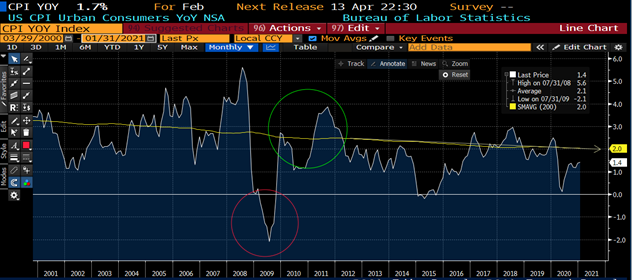
Source: JCB team analysis based on data from Bloomberg.
“Reflation can be seen in the chart above, where the red circle is the negative Consumer Price Index inflation prints from the GFC, followed by a significant rise into the green area following such a bust, before a return to trend inflation thereafter.”
“Secular themes do not change quickly.”
And Charlie believes these trends will continue, as most of the disinflationary forces that we faced pre-pandemic remain. They include:
- Ageing demographics in the developed world,
- High debt levels,
- Job automation,
- Globalisation and under-utilised labour.
“From a secular viewpoint, disinflationary forces have been the overarching force in pricing power for a long time. The combination of poor developed world demographics, high debt levels (interest rate sensitivities and zombie corporate funding), technology progress including automation and robotics, lack of unionisation compared to prior inflationary periods and globalisation itself have all contributed to deflationary or disinflationary forces. Due to the shock of COVID-19 related shutdowns and disruptions, we can now add economic slack and substantial untapped labour pools the world over as a disinflationary force.”
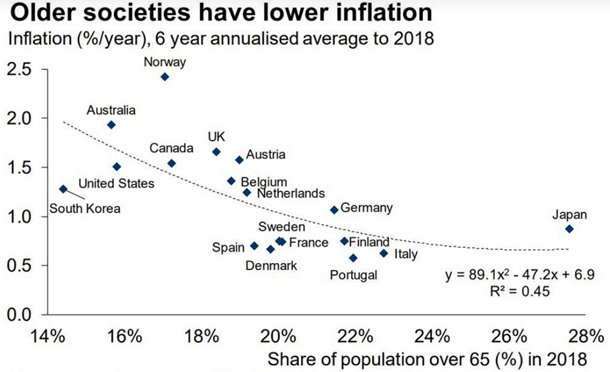
Source: Oxford Economics (UN/OECD)
He says that not only do these forces remain in place, but many of them have accelerated. Debt levels, for example, are much higher now than they were pre-pandemic.
What is a base effect?
Charlie defines a base effect as “the spike (or rapid decline) in inflation 12 months after significant events.” Essentially, after a period of deflation, last year’s numbers (the ‘base’) are well below trend. For example, if the CPI were to fall from 100 to 98 in one year, and then recovered to 102 the following year, this would be reflected as 4.1% year-on-year inflation, despite only rising by 2% over two years.
He says most inflation is transitory, with very specific conditions required for lasting inflation. This is clearly demonstrated in the chart below.
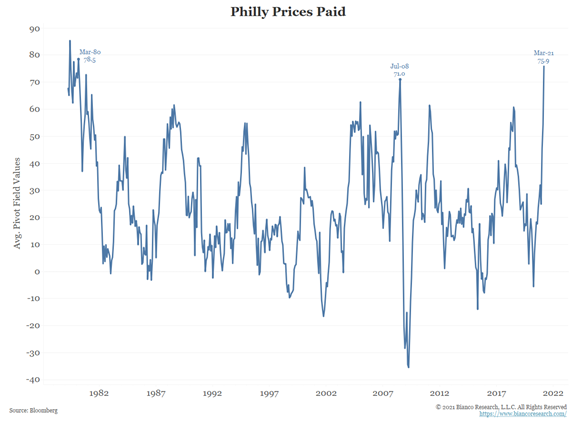
Source: Bianco Research based on data from Bloomberg.
“What do you notice about every explosive peak? A pending collapse shortly thereafter due to powerful transitory forces.”
So what would it take for inflation to stick around? Full employment and wages growth are the best candidates, though even those are a long way off today. Other tail risks could include a major war, or an energy shock (think 1970s oil embargo), though predicting the likelihood or timing of such events is likely a fool’s errand.
In fact, he goes so far as suggesting that even a return to ‘normal’ inflation. The scenario required to achieve such an outcome does indeed seem overly optimistic.
“It is possible that businesses scale up capacity at the same pace as demand rises once the pandemic ends. In this situation, there is no overshoot of inflation to worry about, and the US Fed remains accommodative while workers return to their jobs. Employment steadily rises as vaccines roll out and the economy moves smoothly into a recovery phase. There is no pressure from commentators or politicians to hike rates, as there is no significant inflation to be concerned about. The Fed’s goal in this scenario would be straightforward: do everything it can to ensure that the recovery is as fast as possible to achieve the economic activity and employment levels of 2019. However, this scenario remains unlikely.”
But isn’t inflation bad for bonds?
Common wisdom holds that an inflationary environment and rising interest rates are bad for bond returns. But is that true?
Like many widely held beliefs, there are some flaws to this reasoning.
This idea is based on the premise that ‘duration’ is the primary driver of returns for bonds. Duration refers to the amount of time that an investor must hold an asset in order to receive their returns.
A 1-year bond has less duration than a 10-year bond – unsurprisingly, they have a duration of 1 year and 10 years respectively. This is why a 10-year bond will generally move further in either direction than a 1-year bond when interest rates rise or fall. JCB’s research has shown that duration makes up a relatively small portion of returns, compared to Carry and Roll.
- Carry – the yield the bond provides
- Roll – maturity benefit of a positively sloping term structure (i.e. the value of the bond increases as the repayment date draws closer)
“Even if bonds sell-off in line with the ‘taper tantrum’ of 2013, our calculations indicate the US government bond index would generate a positive return of around 1.90% over the following 12 months.
"Many investors believe duration is the primary driver of bond returns, but that has historically been incorrect in both US and Australian fixed income markets. Instead, the restoration of carry (yield) and roll (curve steepness) sets up a strong profile for go-forward performance.”
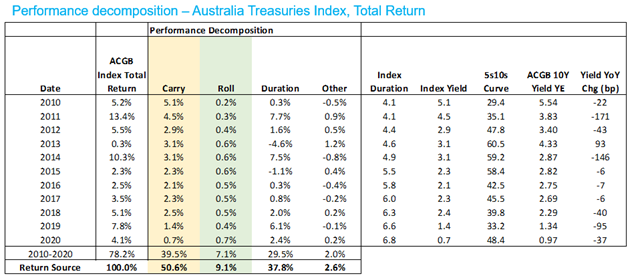
Source: JCB team analysis based on data from Bloomberg.
The window is closing
The returns on risk assets, and equities in particular, have been nothing short of spectacular since last year’s COVID selloff. A combination of low rates, government stimulus and rampant speculation has driven asset prices and valuations to new heights.
“Our concern has been that these moves have continued to defy fundamentals and that equity markets are really acting as one large momentum trade, devoid of linkages to reality. This is concerning as rewards for risks taken are difficult to pinpoint. For instance, despite the backup of bond yields in February, shares were not similarly affected.
"More particularly, at JCB we see limited (muted) upside to shares (or at least little compensation for the risks which are inherent in the economic system as formerly identified). The key takeaway for investors is that understanding the regime we are in, including the movements of global markets and the sub-sectors within them, assists greatly in portfolio management.”
While it might be tempting to reach for the high returns and high yields on offer elsewhere, this year’s bond selloff has set the stage for a period of strong performance.
Following a major selloff in bonds, the Australian Commonwealth Government Bond Index has returned an average of 10.6% in the year the follows (looking at data since 1994).
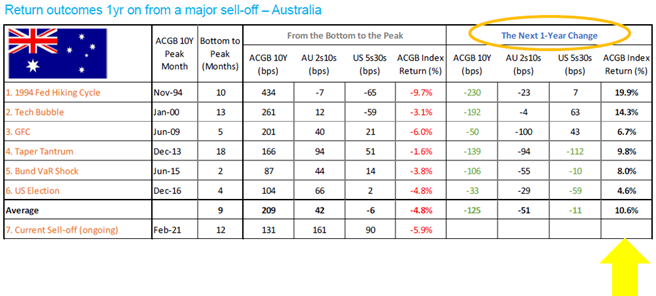
With high equity prices, better ‘carry’ on offer for bonds, and history on the side of bonds, Charlie sees now as an ideal time to rebalance portfolios. Especially given many investors are currently under-weight in defensive allocations.
Indeed even in the time between his writing and mine has proven him right, with bonds rallying since the February selloff. The window of opportunity is closing fast, and the message is clear; don’t get stuck outside in the cold.
Strengthen your portfolio with global high-grade bonds
In times of uncertainty, adding high-grade bonds to your portfolio can provide much-needed stability, liquidity and diversification. Use the 'CONTACT' button to get in touch if you would like to receive a copy of the full five-part whitepaper.
For professional investors and advisors, you can register for the upcoming Jamieson Coote Bonds webinar to hear more of Charlie's current market views. Register here.

1 contributor mentioned

